|
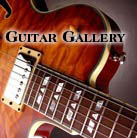

Archives
October 2007
November 2007
December 2007
January 2008
February 2008
March 2008
April 2008
May 2008
June 2008
July 2008
August 2008
Sept-Nov 2008
December 2008
Jan-Mar 2009
April 2009
May 2009
June 2009
Jul-Sept 2009
Oct-Nov 2009
December 2009
January 2010
Return to Blog Index
Return to General Index
|
December 04, 2007
Reports From the Road: Mark Spencer
|
|

| We get a lot of calls and emails from musicians on the road. Sometimes it's a service issue or a request, but often it's a "thank you" or an invitation to a show. Other times, it's just to keep in touch. I like to keep up with the touring and recording artists that we work with because there's always something to learn, and that's what makes us better at what we do.
Recently, my friend Mark Spencer left to go on tour with Aimee Mann, and he's been using his Hamers along the way. Mark has been a busy boy over the years, recording and touring with people like Freedy Johnston, Kelly Willis, Lisa Loeb & Nine Stories, Cheri Knight, Jim Lauderdale, Chantal Kreviazuk, Wanda Jackson, Tammy Faye Starlite, Laura Cantrell, Jay Farrar and a ton of other people. He's excited about hooking up with Son Volt after the first of the new year, but in the meantime he's rockin' the Amiee Mann gig. But, enough of my yackin'... let me turn it over to Mark. This is the letter I got from him the day he took delivery of his Talladega at a studio in Manhattan.
------------
|
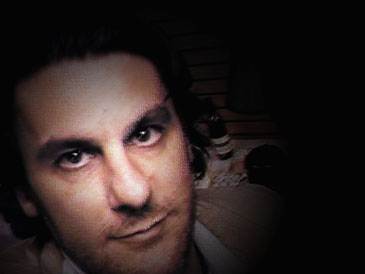
Guitarist Mark Spencer
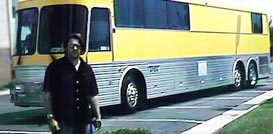
|
Jol,
Got it! And it was in tune! Started recording with it right out of the box.
I used the inbetween 2 p.u. sound... light overdrive into my oahu (new) amp.
Real nice. It's already on the Jim Keller record.
I did do some adjusting, man, that action was set LOW!
I had to raise the action about twice as high, and give a hair of relief to
the neck, it was dead flat. Now it bends way easier and more precisely!
Pretty nice how easy it is to set up, both the saddles and the truss,
precision feel to it and when you make a truss turn (I let it out about a
1/16th of a turn) it actually provides you with reliable, predictable
relief. Nice. My next fun time with it, when not working, will be seeing
what happens with pickup heights. I have no idea how anyone can bend
strings with the action that low! I realize almost all my set up needs are
hard core, Fenderish, and somewhat contrarian, I guess that is what playing
guitar is all about.
Stays in tune great, tunes up easy...that is a super plus.
It JUST went to LA, I'll be using it on tour now, mon. Guess I'll be trial-by-firing it for the next month. Will update regularly.
Many many thanks again, Jol, you can count on me to figuratively play the
shit out of it.
m.
|
December 06, 2007
Vintage, Modern Vintage
| 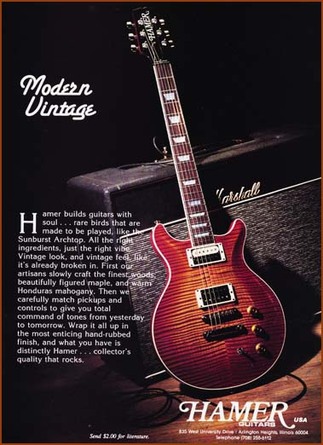
Original ad. (Click to enlarge).
| The birth of "Modern Vintage"
They say time flies when you are having fun, so by that measure, I guess we're having a heck of a lot of fun here in the workshop. I was looking at an ad I did in the late 1980s that featured our classic Studio model leaning up against my little 18 watt 2x12 combo. Then it dawned on me—that was almost two decades ago!
We'd been at the vanguard of the vintage-style movement (which I called Modern Vintage) for quite a while, so it seemed fitting that we'd prop the guitar up against a twenty-plus year old tube amp.
That amp, acquired in the early eighties for around $250.00 is still in my collection, where it has stood the test of time and is now worth more than all the furniture in my house combined. I knew what it was when I got it, but I never imagined that it would become such an icon. Aside from the occasional recording gig, it languished in a closet for years. Then, I was talking to a friend who keeps up with collecting trends, and when I mentioned it to him he nearly fell over. He asked me, "are you sure... it's a real one?"
"Of course," I replied. I told him that I'd owned it since '82, when it was a worthless and obsolete cast-off to its previous owner. That's when my friend hipped me to 18watt.com and all of the lo-power clones that were springing up out of garage workshops around the world. I was flabbergasted. Now, it's a nice little amp, but its "new" value almost takes all the fun out of owning it for me. I'm scared to take it out of the house—I mean, it's dead mint.
| |
For the original ad, ace photographer Paul Natkin and I set up the shot, turned on a single spotlight and wham, called it done. We ran a series of ads and did a catalog full of similar shots that pretty much looked the same. Apparently, we were just a little ahead of our time, as it would be another ten years before curly maple, humbuckers and 18 watts of point-to-point became all the rage.
To bring my story to the point, I decided that maybe we should do a "remake" or sequel, as they say in Hollywood. I called up photographer extraordinaire Rick Whittey and outlined what I wanted. The guitars we make today are better than they've ever been, so I figured that an artist like Rick could create an image that reflected our improvement. Rick and his wife Mary Lou built the set to hint at the original, while giving Rick the depth that is the hallmark of his photographs. Rick likes to get all of the highlights and reflections done in the camera, so the shoot took two days and utilized a half dozen specialty lights. I love the way the carve on the guitar is deep, and the hardware almost looks warm to the touch. I was proud of the original, but I think that the new one takes it to a much higher level. It's just amazing working with people who take such pride in their craft. I think it's worth it, don't you?
| 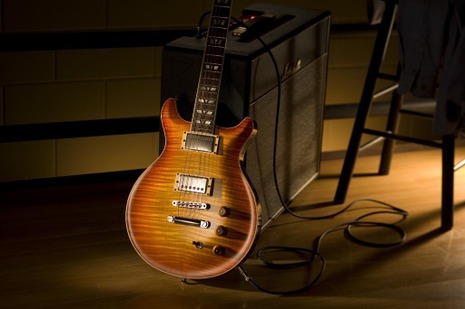
Looking better than ever, the classic Hamer Studio model
(click to enlarge)
|
December 12, 2007
End of the Year Freebies!
|
| |
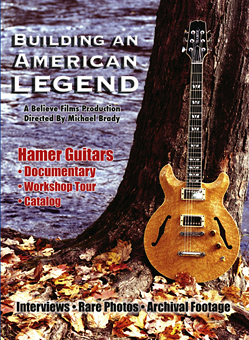
| OK, it's time to stop the giveaway, the response was furious so we've got our hands full now. If you've filled out the form, thanks for playing... for those of you just happening upon this post, I'll get you up to speed on what you missed.
We were going through some stuff the other day (trying to make room for more stuff of course) when we came across a stash of goodies that we give away when I do my clinic tours. I offered to send out some of this stuff as holiday gifts to the first people to follow a link and fill in a form. In came the requests, and so now, out go the packages. Mostly we're sending DVDs of the workshop documentary made by Mike Brady, but there's some other miscellaneous items too.
Here's the Documentary story:
I've known filmaker Mike Brady for a long time—he's been an avid blues and bluegrass musician/fan since we were in high-school. Before he became a big-time Hollywood ad guy, he was a DJ on a local radio station, the manager of Biddy Mulligan's pub in Chicago (where he hired Buddy Guy and Hubert Sumlin when nobody else would) and a general fan of roots music. He took mandolin lessons from Jethro Burns (another Chicago legend) and tape recorded them all. Another passion of Mike's is windsurfing, a sport he helped bring to the Olympics! You might say he's been in the right place at the right time a couple times. Oh, did I mention that he makes over 200 TV commercials each year? If you've watched that big football game (the one that sues you if you use their name) you've seen his work too.
|
|
Mike's watched our business grow from the little storefront in Wilmette, Illinois where we sold vintage guitars to the stars, to the most recent reviews of the Talladega. Over the years, Mike continually bugged me about making a documentary about our shop. His enthusiasm for what we do and our place in the history books of instrument making has never ebbed. Finally, a few years ago, we relented. Mike brought along Director of Photography, Tony Molina, a guy with an eye for composition and movement that stuns the viewer with sheer beauty. You've seen Tony's work on videos by Aerosmith, Sting and Rush among many, many others. If it wasn't for Mike's persuasive ways, we'd never have gotten a guy like Tony.
Between the two of them, they weasled their way into interviews with guys like Tom Wheeler, Art Thompson, the enigmatic Nite-Bob, and K.K. Downing. When they were done, we ran off a few thousand copies to show to friends. Eventually parts made their way onto YouTube (as sampled above) but to appreciate Mike and Tony's work, you've got to watch it on the bigger screen.
For those of you who filled in our form to get your goodies, thanks for stopping by. For those of you who got here too late, we're sorry, but we'll make it up to you in the future. Stay tuned.
|

|
December 16, 2007
(More) Reports from the Road: Mark Spencer #2
We get a lot of calls and emails from musicians on the road. Sometimes it's a service issue or a request, but often it's a "thank you" or an invitation to a show. Other times, it's just to keep in touch. I like to keep up with the touring and recording artists that we work with because there's always something to learn, and that's what makes us better at what we do.
Here's the latest email from Mark Spencer out on the road with Aimee Mann. I've received a lot of positive feedback from the Hamer nutniks who have gone to see the show, so without any more flap...
| |
Jol,
Even though the Talledega is awesome, and I'm using it more and more, messing with the action, rocking some leads on it, the real king of the show for me is the Monaco III. This is really the first time I've been able to play it so much, in such an appropriate setting for it, that it's been easy to become one with it. Also much props to Aimee's guitar tech Rick Sanger for stringing it and STRETCHING the strings just right so that the Bigsby stays in tune and works perfectly. A lot of the tunes on the show are traditional xmas tunes like "I'll Be Home for Christmas" and "The Christmas Song" (chestnuts roasting, etc...) and for these I had to look under my bed and retrieve what I refer to as my jazz "chop" (for chops would be too grandiose in my case). In the words of Chuck Prophet in San Francisco he only partially sardonically said I sounded like "fucking Joe Pass up there", and I'm pretty sure that a good portion of however real that is, is due to the Monaco on the neck pickup, sounding as authentic as a P-90 hollow body oughtta. Later it turns into a David Lynch / dark twang machine on the Grinch and other tunes, and also delivers the medium to crunchy rock, and sounds particularly lugubrious and decadent with a Leslie simulator.
| |
My only real niggle (hey I'm a guitar player!) is the the switch. Although looking snazzy in a retro way, that rotary chicken-head I find almost impossible to make split second pickup changes with, a blade style switch, possibly placed in a different archetypal part of the real estate (say for instance where the Talledega switch is placed) might allow some more surgical pickup combos, (although there is that Bigsby arm to ponder) and as a further niggle I think any guitar with more than one pickup should feature the Neck/Bridge combo no matter what it takes, including getting rid of one pickup! But seriously, is there a way to wire it for this combination? One can only imagine what a 3-tone vintage sunburst Monaco III with Lollar humbuckers would be capable of. I can't wait to put the Talledega to the honky tonk twang test with Jimmy Ryan next time we do a gig in NYC, and square off against his new Creston electric mando.
Mark
(12.12.07, 3:26 AM, on the bus....wi fi!)
| 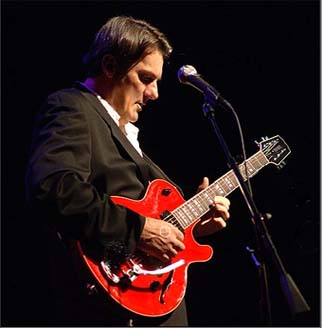
|
December 19, 2007
"Kimono Gold" Greg V Talladega Project
|
One of my inspirations for the Talladega came from listening to Greg V's CD Tailgate Troubadour. Introduced by a mutual friend, Greg and I developed a bond over the course of time I was immersed in the development of theTalladega and the Double D pickups. His input was instrumental in the direction I took. Our conversations about attack, decay and string separation drove me to evaluate pickup after pickup and prototype after prototype. When I shipped the first Talladega to Greg, I waited nervously for days before he called with his feedback—I wanted him to love this guitar they way I did, because it was so intertwined with our friendship. Happily, he did, and so does just about anyone else who's played one.
| |
Of course, as is often the case, Greg wanted a second one. For an encore, I decided to make Greg an even more special guitar with a cool finish based upon an eighty year old "lost art" technology that was used on old resonator guitars. I knew Greg was a fan of Goldtop guitars, so I went ahead and finished off his new axe in gold crystalized lacquer and complemented the old-school appearance with distressed nickel hardware. It's not really a Designer model, but I wanted to share it, so enjoy. Oh, and don't forget to click on the photos to see 'em up close!
| 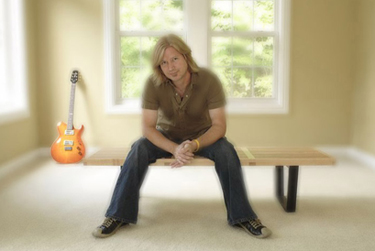
| The crystalized paint follows its own muse and no two patterns are ever the same. The surface tension over the gentle curve of the top near the strap button created a form that looks like a flower.
| 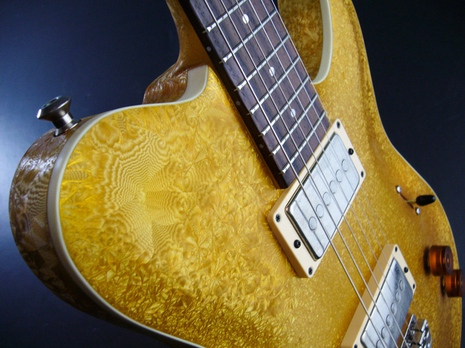
| This angle shows the soft blend where the neck and body meet as well as the way the finish transitions from small, tight patterns to larger ones on the neck. It takes over an hour just to blend the joint by hand.
| 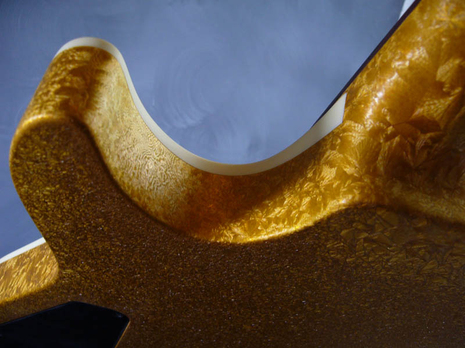
| This angle shows off the gorgeous curves of the Talladega's body. I like using the old style lap-steel knobs, and they really look good with the gold finish.
| 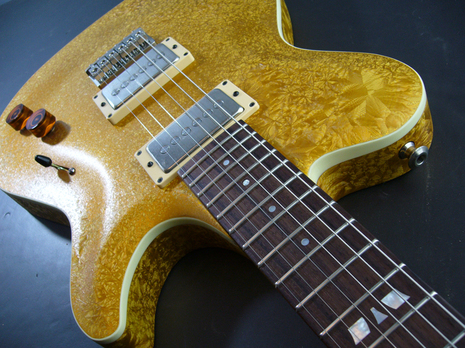
| Here's a good look at our nickel plated cup jack. I distressed the black anodized aluminum backplate to make it fit with the rest of the hardware.
The overall effect is one of muted highlights and subtle gloss. I like the vintage vibe and how everything works together. How does it sound?
| 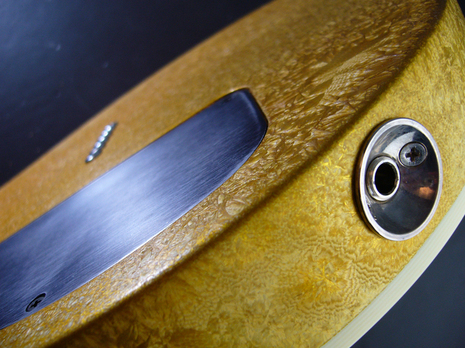
|
|
December 30, 2007
As the Earthen Turns
Our Earthen Maple guitars are coming along nicely, and soon I'll be able to show you the final result. We decided to go with the larger chambering as it gave the prototype a distinctive upper midrange signature that is unique to this series of guitars. It's not going to be a mid-bass heavy heavy rock sound as much as a jangly pop-rock or R&B machine. Of course, there will be those who prove me wrong by tuning theirs down to C and plugging it into three 100w half-stacks.
In the meantime, let's catch up on some of the steps that led to the neck that was featured a few weeks back.
| After Tom reassembles the matched trio of limba boards into a solid block, he outlines the rough shape and cuts it out on the bandsaw.
| 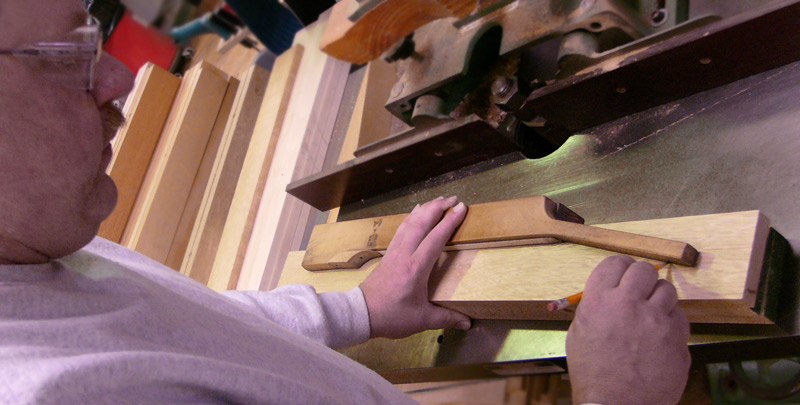
| The block yields two complete neck blanks—the center pieces will be kept for the "ears" of the headstocks. By using the same wood for the ears, the neck is actually made from a single board and all the densities of the pieces will match up both visually and in terms of resonance.
| 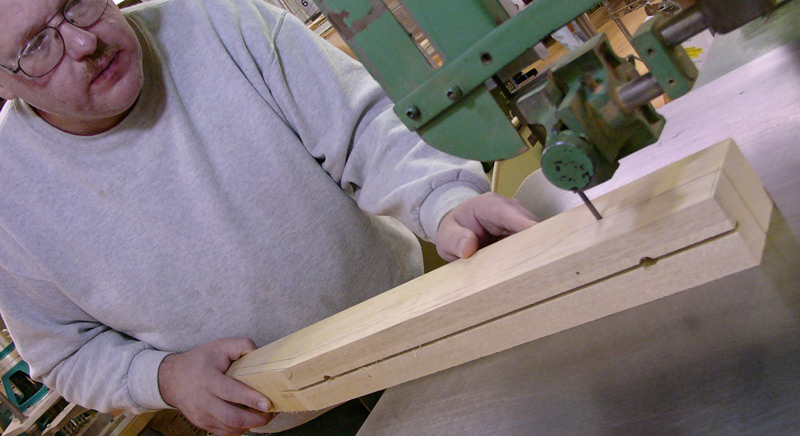
| Here, Tom glues the ears on three blanks and clamps them up to dry.
| 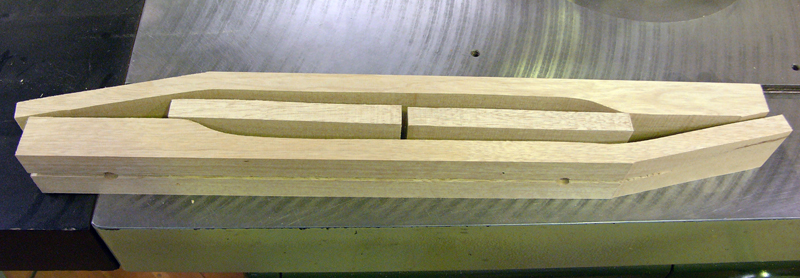
| Dave and Enrico have matched up twenty-five tops and backs, so this run of guitars will be limited to that number. Accordingly, Tom has been busy getting the necks built and onto the "curing" rack so they'll be ready when the bodies start coming through. Next stop, the fitting area and then the spray booth!
| 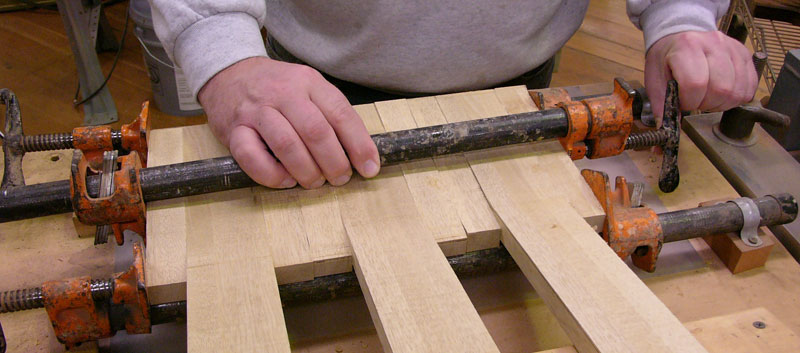
|
| Previous month
| Next month
| |


















